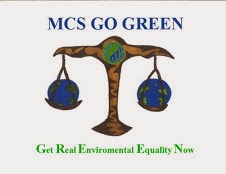by Kristen Berger
While the 7th graders were at the Farm, 8th graders participated in several activism related activities. On Monday, they were led on a tour of East Harlem by Ann-Gel Palermo of Mount Sinai's Center for Community and Multicultural Affairs. Along the tour, Ann-Gel drew our attention to the disparity of look and feel between Fifth Avenue and Madison between 96th Street, where the tour began and MCS is located, and 105th Street. Along Fifth Avenue, or Museum Mile, there are cultural institutions, fancy townhouses and Central Park. Just a few blocks later, the landscape is filled with housing projects and a lack of green spaces.
Ann-Gel reinforced that "you are only as healthy as your community" and noted that public housing in East Harlem is poorly maintained and has problems with mold, effective heating/cooling, and cramped, dark places. This atmosphere creates health problems in people that live in public housing. People in public housing are also often stuck there because the price differential between rent for public housing and the next available New York City apartment is prohibitively large. And, when occupants attempt to advocate on their own behalf and contact the New York City Housing Authority to fix problems, they often get no response or a very delayed response.
At other stops on the tour, we noted the lack of places for kids to play and the high density of people living in East Harlem. The one outdoor play space that had a track and swimming pool also was between the FDR Drive and 1st Avenue, a major thoroughfare. At this park, kids are breathing in exhaust as they play.
We also discussed the designation of East Harlem as a "food desert." There were very few grocery stores with fresh food along the walk. Instead, residents were forced to shop at bodegas that advertised fried foods that were high in fat.
While many aspects of the tour focused on the negative impact of the environment on community health, Ann-Gel also noted the successes that activists have had in the neighborhood retaining and celebrating Latino culture through institutions such as El Museo del Barrio and the creation of community gardens.
While the 7th graders were at the Farm, 8th graders participated in several activism related activities. On Monday, they were led on a tour of East Harlem by Ann-Gel Palermo of Mount Sinai's Center for Community and Multicultural Affairs. Along the tour, Ann-Gel drew our attention to the disparity of look and feel between Fifth Avenue and Madison between 96th Street, where the tour began and MCS is located, and 105th Street. Along Fifth Avenue, or Museum Mile, there are cultural institutions, fancy townhouses and Central Park. Just a few blocks later, the landscape is filled with housing projects and a lack of green spaces.
Ann-Gel reinforced that "you are only as healthy as your community" and noted that public housing in East Harlem is poorly maintained and has problems with mold, effective heating/cooling, and cramped, dark places. This atmosphere creates health problems in people that live in public housing. People in public housing are also often stuck there because the price differential between rent for public housing and the next available New York City apartment is prohibitively large. And, when occupants attempt to advocate on their own behalf and contact the New York City Housing Authority to fix problems, they often get no response or a very delayed response.
At other stops on the tour, we noted the lack of places for kids to play and the high density of people living in East Harlem. The one outdoor play space that had a track and swimming pool also was between the FDR Drive and 1st Avenue, a major thoroughfare. At this park, kids are breathing in exhaust as they play.
We also discussed the designation of East Harlem as a "food desert." There were very few grocery stores with fresh food along the walk. Instead, residents were forced to shop at bodegas that advertised fried foods that were high in fat.
While many aspects of the tour focused on the negative impact of the environment on community health, Ann-Gel also noted the successes that activists have had in the neighborhood retaining and celebrating Latino culture through institutions such as El Museo del Barrio and the creation of community gardens.
.JPG)
.JPG)



.JPG)
